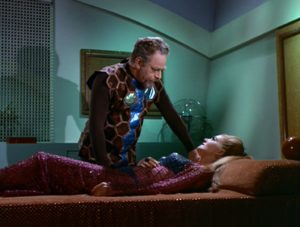Technical Specs
Director: Jud Taylor
Writers: George F. Slavin and Stanley Adams
Cast: William Shatner, Leonard Nimoy, DeForest Kelley, Sharon Acker, David Hurst, James Doohan, George Takei, Nichelle Nichols, Walter Koenig, Gene Dynarski, and Richard Derr
Composer: Fred Steiner
Air Date: 1/17/1969
Stardate: 5423.4
Production #: 60043-72
Overview
After attempting to beam down to the planet Gideon, Captain Kirk finds himself aboard a version of the Enterprise devoid of occupants save for a mysterious woman named Odona (Sharon Acker). Unable to contact the captain, Spock must negotiate with the bureaucratic Ambassador Hodin (David Hurst),  whose lackadaisical attitude regarding Kirk’s disappearance prompts the first officer to conduct an investigation of his own.
whose lackadaisical attitude regarding Kirk’s disappearance prompts the first officer to conduct an investigation of his own.
“The Mark of Gideon” establishes an ominous atmosphere stemming from Kirk’s predicament, but fails to maintain tension following a nonsensical plot twist. Nevertheless, Star Trek fans may appreciate the thoughtful commentary showcased in this offering.
Pros
 When Kirk and Odona roam the Federation flagship turned ghost vessel, a most eerie sensation of “being watched” trails both characters at all times. This unnerving impression is confirmed when a gallery of green heads—all of which appear to levitate in midair—flashes on the viewscreen while the captain and his “guest” share a tender embrace. Though such a display may unintentionally elicit laughter from audiences of an unserious inclination, the very concept of luminous aliens studying humanoid subjects as if for experimental purposes is a chilling one indeed.
When Kirk and Odona roam the Federation flagship turned ghost vessel, a most eerie sensation of “being watched” trails both characters at all times. This unnerving impression is confirmed when a gallery of green heads—all of which appear to levitate in midair—flashes on the viewscreen while the captain and his “guest” share a tender embrace. Though such a display may unintentionally elicit laughter from audiences of an unserious inclination, the very concept of luminous aliens studying humanoid subjects as if for experimental purposes is a chilling one indeed.
Cons
While the premise of Captain Kirk stranded on a duplicate Enterprise is intriguing, “The Mark of Gideon” contains one significant flaw: no explanation is provided as to how the Gideons obtained an Enterprise diagram, which would have presumably been required in order to construct such a convincing  replica of the vessel’s interior.
replica of the vessel’s interior.
Also problematic is the fact that, despite having lived on the Enterprise for three years, Kirk is not able to surmise that his surroundings must be false. Even if one were to assume that the Gideons recreated every internal facet of the ship without flaw, subtle differences in background noises and even scents associated with various locations would likely prevent the captain from accepting his circumstances at face value.
Analysis
At its core, “The Mark of Gideon” is a commentary—albeit not a terribly well-disguised one—on late-1960s overpopulation concerns and their inevitable influence on social issues of the time period, including any controversial arguments pertaining to the ethics of birth control that were often raised as a result. In this case, Captain Kirk offers a compelling, if overtly secular, defense for the efficacy of contraceptive methods. On the other hand, Ambassador Hodin and his fellow Gideons assume the position of many religious authorities, who claim to oppose such measures given their extraordinary respect for human life. The metaphorical undertones outlined above lack a certain nuance that one would expect of an intelligent social analysis; however, the central thesis underlying this episode is never presented in a preachy or insensitive fashion and should therefore be commended regardless of any minor shortcomings.
period, including any controversial arguments pertaining to the ethics of birth control that were often raised as a result. In this case, Captain Kirk offers a compelling, if overtly secular, defense for the efficacy of contraceptive methods. On the other hand, Ambassador Hodin and his fellow Gideons assume the position of many religious authorities, who claim to oppose such measures given their extraordinary respect for human life. The metaphorical undertones outlined above lack a certain nuance that one would expect of an intelligent social analysis; however, the central thesis underlying this episode is never presented in a preachy or insensitive fashion and should therefore be commended regardless of any minor shortcomings.
Concluding Comments
A flawed but occasionally captivating effort, “The Mark of Gideon” will appeal to Star Trek enthusiasts who prefer political and cultural discussions over riveting space battles. The structurally realistic but lifeless Enterprise might, however, have made for a more appropriate plot device in a narrative featuring alternate dimensions as opposed to alien tricksters.
Overall Quality: 6/10
If you enjoyed this post, please click the follow button or enter your email address in the subscription box to stay tuned for more updates.
